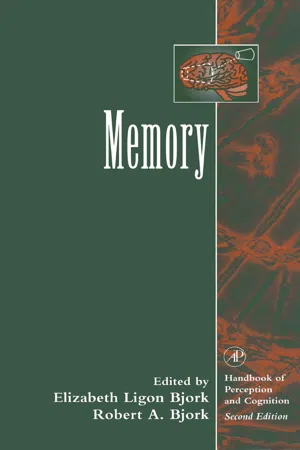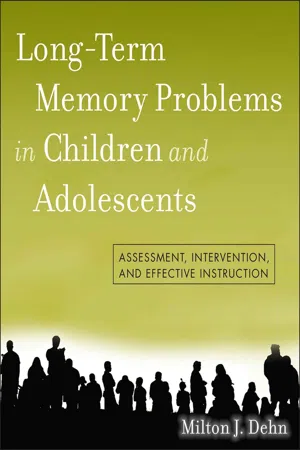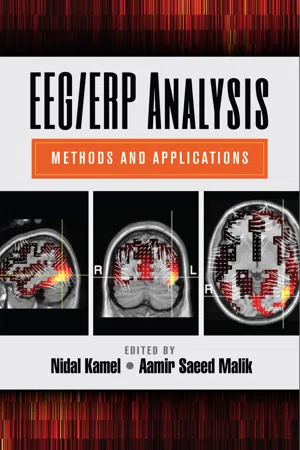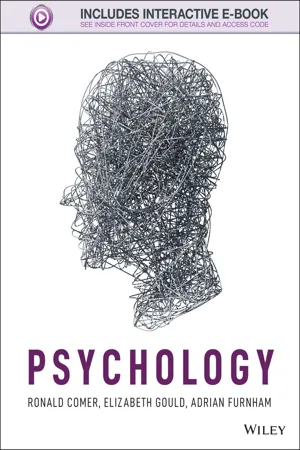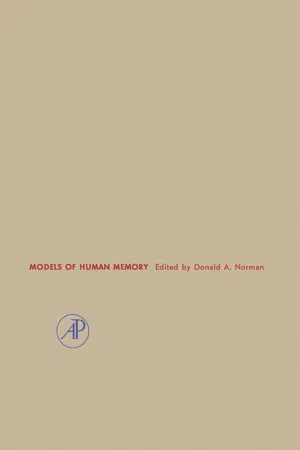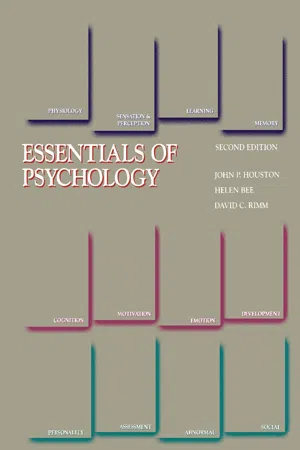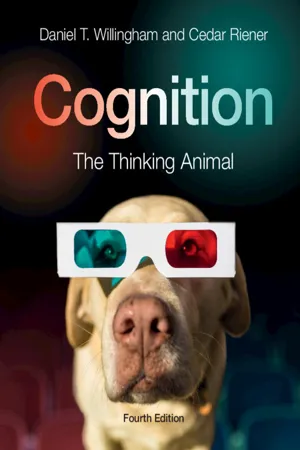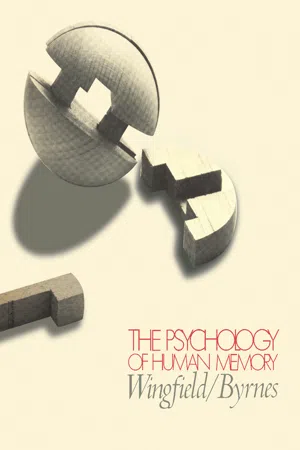Psychology
Memory Processes
Memory processes refer to the cognitive activities involved in encoding, storing, and retrieving information. Encoding is the process of transforming sensory input into a form that can be stored in memory, while storage involves maintaining the encoded information over time. Retrieval is the process of accessing and bringing stored information into conscious awareness. These processes are essential for learning, decision-making, and problem-solving.
Written by Perlego with AI-assistance
Related key terms
1 of 5
10 Key excerpts on "Memory Processes"
- eBook - PDF
- Elizabeth Ligon Bjork, Robert A. Bjork(Authors)
- 1996(Publication Date)
- Academic Press(Publisher)
Accessing Information in Long-Term Memory This Page Intentionally Left Blank : H A P T E R Retrieval Processes Henry L. Roediger, III Melissa J. Guynn The key process of memory is retrieval. DEndel Tulving (1991) I. INTRODUCTION Processes of learning and memory are typically conceptualized as involving at least three stages: encoding, storage, and retrieval (Melton, 1963). Encod- ing refers to initial learning or acquisition of information. Within the con- text of chapters in the present volume, encoded information would certainly have passed through sensory storage systems and in most treatments would also have been recoded into a short-term store (or primary memory, or working memory). Storage refers to maintaining information over time. The usual description of the information during the storage stage is in terms of memory traces. The idea is that encoding processes leave a residue in the nervous systemmmemory tracesmthat persist over time. The third stage, retrieval, refers to accessing stored information. Retrieval processes, then, refer to the means of using stored information; they are the topic of this chapter. However, as the foregoing should make clear, retrieval processes are inextricably bound to those of encoding and storage. Although we can focus on factors that are manipulated at the retrieval stage, we cannot ignore the other stages. How an event is encoded and stored determines how well it can be retrieved later, and what cues will effect its retrieval. It is a curious fact that the retrieval phase of memory was largely ne- glected by researchers until the mid-1960s. One could find occasional men- tion of its importance by experimental psychologists (K6hler, 1947; Melton, Memory Copyright 9 1996 by Academic Press, Inc. All rights of reproduction in any form reserved. 197 198 Henry L. Roediger, III and Melissa J. Guynn 1963), but investigators rarely created conditions to study retrieval direct- ly. - eBook - PDF
- Nancy Ogden, Michael Boyes, Evelyn Field, Ronald Comer, Elizabeth Gould(Authors)
- 2021(Publication Date)
- Wiley(Publisher)
By keeping a record of our past, our memory takes us out of an infinite present. What Is Memory? LEARNING OBJECTIVE 1 Define the basic activities of memory and describe two major models of memory. Simply put, memory is the faculty for recalling past events and past learning. This definition is perhaps the only thing about memory that is simple. Although psychologists often differ in their ideas about memory, they generally agree that it involves three basic activities: • Encoding—Getting information into memory in the first place • Storage—Retaining memories for future use • Retrieval—Recapturing memories when we need them For example, when you attend a concert, you may transform the sights and sounds produced by the performing band into a kind of memory code and record them in your brain (encoding). This information then remains stored in the brain until you retrieve it at later times—such as when you see photos of the band online, watch their music videos, or decide which of the band’s songs to download. At times of retrieval, the original concert event, including the feelings of exhilaration and joy that you experienced at the concert, may come rushing back. How do we manage to encode, store, and retrieve information? Psychologists have devel- oped a number of models of explanation, including the information-processing model and the parallel distributed-processing model, or connectionist model. The information-processing model of memory has its roots back in early computer science (Atkinson & Shiffrin, 1968) and was intended to chart the ways that, like computers, humans process information from their senses into memory. The information-processing model of memory holds that information must pass through three stages, or systems, of mental functioning to become a firmly implanted memory—sensory memory, working memory, and long-term memory (see Figure 8.1) (Estes, 2014b; Kandel, Dudai, & Mayford, 2014; Dudai, 2011). - eBook - ePub
Long-Term Memory Problems in Children and Adolescents
Assessment, Intervention, and Effective Instruction
- Milton J. Dehn(Author)
- 2010(Publication Date)
- Wiley(Publisher)
Human memory systems have different functions and handle distinct types of information. Not only do separate memory systems deal with distinct kinds of information, but they operate according to different principles and rely on different neural structures and processes (Tulving, 1993). Nonetheless, each cognitive event or learning experience draws on a unique combination of components from one or more memory systems. That is, there is seldom a one-to-one correspondence between the information being encoded and a particular memory system. However, memory systems can operate independently of one another. For instance, an individual who appears to have total amnesia for explicit forms of memory can still learn and remember through the implicit (unconscious) memory system. Despite the diversity of storage systems, a common set of cognitive processes enables much of the encoding, storage, and retrieval of information.The purpose of this chapter is to help readers begin to unravel the complexities and mysteries of human memory and to gain an understanding of how all the pieces and processes work in unison. The chapter will begin by discriminating among short-term, working, and long-term memory, and by examining the components of each. The discussion will then focus on the divisions of long-term memory, with emphasis on the types of memory most closely related to academic learning. Details on all of the memory processing from input to output will then be provided, along with a discussion of forgetting and some cognitive theories of memory organization. By the end of the chapter the reader should have a grasp of memory fundamentals and begin to foresee assessment possibilities and educational implications. This chapter focuses on cognitive models of memory, whereas Chapter 3 describes memory functions from a neurological perspective.THE FLOW OF INFORMATION
Memory has been investigated since the early days of psychology (Ebbinghaus, 1913), but only in recent decades have psychologists reached a consensus about its structures and functions. There was even uncertainty over the division of memory into short-term and long-term components until early neuropsychological studies in the 1940s confirmed the distinction. Building on this finding, cognitive models of memory and information processing originated in the 1950s and evolved into the elaborate multi-component models that are now supported by neuroscientists’ brain imaging research. It is difficult to represent complex human memory structures and functions in a figure, and consequently the general information processing model has been criticized as being overly simplified. Nonetheless, the classic model (see Figure 2.1 - eBook - PDF
EEG/ERP Analysis
Methods and Applications
- Kamel Nidal, Aamir Saeed Malik, Kamel Nidal, Aamir Saeed Malik(Authors)
- 2014(Publication Date)
- CRC Press(Publisher)
It is the first stage of creating a new memory in the brain. Retention is the storage of encoded information in the brain. Retrieval or recall is the re-accessing of retained events or information in the brain. A part of encoding or retention is mem-ory consolidation, which stabilizes a memory trace after its initial formation. Neurologically, the consolidation process employs long-term potentiation; it strengthens the synapses by increasing the number of signals that are sent and received between the two neurons. Scientists utilized different neuroimaging techniques to view these pro-cesses such as electroencephalography (EEG), functional magnetic reso-nance imaging (fMRI), magneto-encephalography (MEG), positron emission tomography (PET), etc. This chapter will focus on recent studies utilizing EEG for the two important Memory Processes: (1) retention and (2) recall, by focusing on their neurophysiological understanding and studying the factors that affect the retention and recall performance. The following sections will describe the traditional cognitive and memory theories of Memory Processes, the brain regions associated with memory functions, the neural understand-ing of retention and recall, applications and, finally, the conclusions. 10.2 Overview of Traditional Approaches 10.2.1 Atkinson and Shiffrin Memory Model (1968) Richard Atkinson and Richard Shiffrin proposed a multi-store human mem-ory model (see Figure 10.2 [2]) that divided the human memory into three distinct stores: sensory memory, short-term memory (STM), and long-term memory (LTM). This model has many limitations and has attracted much Input (stimuli) Sensory memory Attention Short-term memory Forgetting Long-term memory Rehearsal Rehearsal Retrieval Encoding FIGURE 10.2 Atkinson and Shiffrin memory model. (From Atkinson, R. C. and Shiffrin, R. M. The Psychology of Learning and Motivation, 2, 89–195, 1968.) - eBook - PDF
- Ronald Comer, Elizabeth Gould, Adrian Furnham(Authors)
- 2014(Publication Date)
- Wiley(Publisher)
• Storage – Retaining memories for future use. • Retrieval – Recapturing memories when we need them. These three stages work together. For any single memory event, all three need to have been achieved. In memory clin- ics, neurologists sometimes ask people to report what they had for breakfast. You can consider this simple question now, and form an answer. To be able to report this informa- tion, you need to have been paying attention to breakfast in the first place in order to encode it, then information con- cerning breakfast needs to have been meaningfully stored and, finally, when asked, you need to successfully travel back (mentally) to the right time point and to the right informa- tion. This may even involve some mental effort, or the sen- sation that information is rushing back. But a disruption to any of these three stages will mean that the information is lost, even if only temporarily. How do we manage to encode, store and retrieve infor- mation? Psychologists have developed a number of models of explanation, including the information-processing model and the parallel distributed-processing model, or connectionist model. The information-processing model of memory holds that information must pass through three stages, or systems, of mental functioning in order to become a firmly implanted memory: sensory mem- ory, working memory and long-term memory (Figure 10.1) (Dudai, 2011; Nee et al., 2008). When we first come across a stimulus, we retain a sensory image – or sensory memory – of it for less than a second. Sensory memories help us to keep alive items that we have experienced briefly a bit longer, so that we can, in a sense, decide whether to pay further atten- tion to them. If, for example, we are copying from one piece of text while typing, we will store a brief sketch of where in the document we are looking, before turning to the computer and turning back again. - eBook - PDF
- Donald A. Norman(Author)
- 2013(Publication Date)
- Academic Press(Publisher)
This is due in part to increased sophis-tication in the art of conducting experiments on memory, at the level of neural processes and at the level of psychological processes. In part, it is due also to the desire to explore possible implications for memory theory of the exciting developments in the theory of biological infor-mation encoding and storage mechanisms. And, in part, this new vigor is the result of the introduction in the 1950's, and subsequent wide-spread acceptance of, a new vocabulary of terms and concepts for de-scribing cognitive processes: the language of information processing theory. Such terms as buffer storage, coding, retrieval processes, and processing strategy are familiar and commonly used labels, even among those psychologists who do not think of themselves as information pro-cessing theorists. This attempt to bring a reasonable amount of order to the study of memory has been two headed: the search for an adequate description of Memory Processes and the search for models of the information stor-age structures that might be involved. This section of the chapter pre-sents the elements of an information processing theory of memory in-corporating an integrated set of hypotheses about both information processes and information structures of memory. The EPAM model consists of information processes and structures for learning and per-formance in paired-associate and serial verbal learning tasks. The job of the EPAM performance processes is to retrieve appropriate responses from the memory structures when the task so dictates. EPAM has two major learning processes: discrimination learning and stimulus famil-iarization. The former discovers differences between items being learned and those already learned, and builds up the memory structure to incorporate tests on these differences, so that storage and retrieval can take place with a minimum of stimulus generalization and confusion. - eBook - PDF
- John P. Houston, Helen Bee, David C. Rimm(Authors)
- 2013(Publication Date)
- Academic Press(Publisher)
This new approach con-ceives of the human being as an information*processing system. Accord-ing to this way of thinking, memory involves the flow of information through the organism, beginning with encoding and storage and ending with the retrieval of stored information. The number of specific models of memory that have developed within this new tradition is quite astounding (see Atkinson & Shiffrin, 1971; Broadbent, 1971; Craik & Lockhart, 1972; Hilgard & Bower, 1975; Lind-say & Norman, 1977; Ratcliff, 1978; Wickelgren, 1979). We will con-sider a model of memory that represents a distillation of several different models, because many of the available models agree with one another in important ways. These areas of agreement are summarized by the flow diagram in Figure 5. Notice that the model in Figure 5 contains three distinct types of memory—sensory memory, short-term memory, and long-term memory. Most recent information-processing models define three types of memory, while the older interference theory specifies only one memory process. In Figure 5 information is presumed to move through these three memory systems from left to right. Perceived information first FIGURE 5 The three human memory systems. Stimulus Sensory memory Rehearsal Short-term memory Long-term memory Retrieval o / 7 V 174 Chapter 5 Memory enters sensory memory; it may then be transferred to short-term memory, and finally to long-term memory. In essence, the argument for having three memories, or stores, is that the ways in which we remember items for very short periods of time differ from the ways in which we remember the same items for long periods of time, For example, if you wanted to remember 193-2040 for a very short time (say, 30 seconds), you might do it by remembering the sounds of the numbers and by arranging these sounds into some easily remembered pattern or rhythm such as one-nine-three-twenty-forty. - eBook - PDF
Cognition
The Thinking Animal
- Daniel T. Willingham, Cedar Riener(Authors)
- 2019(Publication Date)
- Cambridge University Press(Publisher)
7 Long-Term Memory Processes Memory Encoding What Improves Memory Encoding? • Levels of processing • Emotion and memory • Flashbulb memories • Adaptive processing What Doesn’t Improve Memory Encoding? • Intention to learn • Sheer repetition What Effect Does Prior Knowledge Have on Memory Encoding? • Prior knowledge reduces what you have to remember • Prior knowledge guides the interpretation of details • Prior knowledge makes unusual things stand out In the previous chapter we considered the structure of our memories. What are the different kinds of memories? How are they organized? In this chapter and the next we will focus on the processes that turn experiences into memories and help us recall these memories later. Each chapter describes one of the two basic processes of memory: encoding and retrieval. Encoding is the process by which memories are “put in. ” We may think of encoding information as “learning” but “experiencing” is probably a better approximation, because anything we experience is a candidate to make an enduring new memory. In Chapter 5 we described working memory as a short-term buffer that processes our experiences. In this chapter, we will discuss what makes information from that buffer get transferred or encoded into long-term memory. Think about it this way. Working memory is the site of awareness; much of what passes through working memory is lost forever. Perhaps three weeks ago you were driving down an interstate highway looking for a place to eat and saw that Exit 92 offered a McDonald’ s, a Subway, and SpeedyBurger (whatever that is). At that moment you were aware of the three restaurants off Exit 92; that information was in working memory and it could have been stored in long-term memory. It wasn’ t, as indeed, most things are not. What if you wanted to make sure that some piece of information was saved for later? Our first question addresses this concern: What improves memory encoding? - Lorelle J. Burton, Drew Westen, Robin M. Kowalski(Authors)
- 2022(Publication Date)
- Wiley(Publisher)
CHAPTER 10 Memory LEARNING OUTCOMES After studying this chapter, you should be able to: 10.1 describe memory and outline the model of information processing 10.2 describe working memory 10.3 outline the major types of long-term memory 10.4 describe how information is encoded and organised in long-term memory 10.5 explain why remembering, misremembering and forgetting occur. CONCEPT MAP Memory Memory and information processing • For information to come back to mind after it is no longer present, it has to be represented. Sensory representations store information in a sensory mode; verbal representations store information in words. • The standard model of memory is predicated on the metaphor of the mind as a computer; it distinguishes three memory stores: sensory memory, short-term memory (STM) and long-term memory (LTM). Working memory • Working memory refers to the temporary storage and processing of information that can be used to solve problems, respond to environmental demands or achieve goals. • Baddeley and Hitch’s (1974) model proposed rehearsal, reasoning and making decisions about how to balance two tasks are the work of a limited-capacity central executive system. • Most contemporary models distinguish between a visual store (the visuospatial sketchpad) and a verbal store (phonological or articulatory loop), and more recently, the episodic buffer (a temporary integrative stor- age system). • Working memory and LTM are distinct from one another in both their functions and neuroanatomy, but interact to help enhance memory capacities. Varieties of long-term memory • Declarative memory refers to memory for facts and events; it can be semantic memory or episodic memory. Procedural memory refers to ‘how to’ knowl- edge of procedures or skills. • Explicit memory refers to conscious recollection. Implicit memory refers to memory that is expressed in behaviour. • Everyday memory refers to memory as it occurs in daily life.- eBook - PDF
- Arthur Wingfield, Dennis L. Byrnes(Authors)
- 2013(Publication Date)
- Academic Press(Publisher)
These findings were described in the previous chapter and remain part of the data base for our changing speculations about the nature of the human memory system. The duplex theory of memory, that long- and short-term retention are represented by qualitatively different structures, interpreted these ex- 306 Chapter light Levels of Processing and Mental Representation perimental results as evidence for the fixed characteristics of these structures. As we have seen, however, additional research has shown that more than one type of code can be used at any retention interval, and that unrehearsed material seen in a single glance is sometimes forgotten and sometimes not. These ambiguities began to blur the notion that memory performance could be explained by an inflexible sequence of operations that placed information into structural stores with fixed characteristics. The structural notion seemed too inflexible to accommo-date the variety of results that could be produced under different conditions and instructions. A process view, such as the levels framework, suggests that all of these findings could be products of the amount and quality of mental activities that are performed on the incoming information. Memories are perhaps better described as a record of mental operations. Emphasis was shifted from the characteristics of storage structures to the characteris-tics of processes used to analyze a stimulus and the processing resources necessary to carry out these analyses. Our concluding view is intuitively related to William James' notion of the psychological present. Short-term retention is the immediate product of our cognitive activities, rather than a box which merely holds memories of recent events. Because it involves the activation of structures and processes we already possess, it participates fully in the same organization as that of long-term memory. You may have noticed how this perspective dovetails with the capacity notions of attention we saw in Chapter 6.
Index pages curate the most relevant extracts from our library of academic textbooks. They’ve been created using an in-house natural language model (NLM), each adding context and meaning to key research topics.
